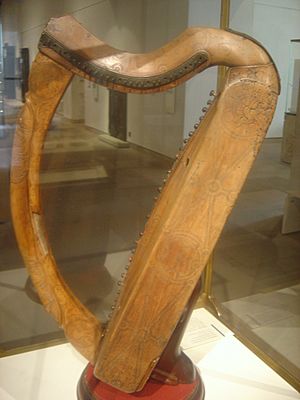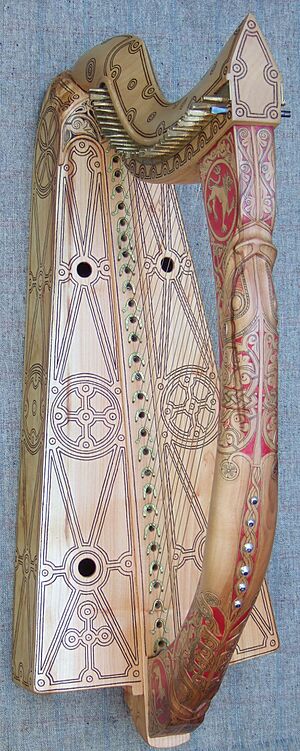Queen Mary Harp facts for kids
The Queen Mary Harp (which is Clàrsach na Banrìgh Màiri in Scottish Gaelic) is a very old and special Scottish musical instrument. It's also known as the Lude Harp. You can see it today at the National Museum of Scotland in Edinburgh. This amazing harp is thought to be from the 1400s. It likely came from a place called Argyll in South West Scotland. It's one of only three ancient Gaelic harps that still exist! The other two are the Lamont Harp and the Trinity College Harp.
Contents
The Harp's Journey Through Time
The Queen Mary Harp is believed to have been made around the year 1500. A famous story says that Mary, Queen of Scots, gave this harp to a musician named Beatrix Gardyn in 1563. This happened during one of the Queen's hunting trips. Some people say the harp once had a small gold picture of Queen Mary on it. This is why it's called the Queen Mary Harp!
Who Played This Ancient Harp?
After Beatrix Gardyn, the harp was passed down through the Robertson family in Lude, Perthshire. Beatrix Gardyn's son had a helper in 1588 named Anthony McEwan McChlairser. His last name means "son of the harper," which gives us a clue about who might have played this beautiful instrument. The last person known to play the harp was John Robertson of Lude, who lived until about 1729. The songs he played were written down and published in 1789.
What Does the Queen Mary Harp Look Like?
The Queen Mary Harp is special because it's the most complete and best-preserved of all the old harps. It has amazing and detailed carvings all over it. The front part, called the Lamhchrann, has a fancy carving of a creature with two heads.
Hidden Colors and Symbols
You can still see tiny bits of color on the harp today. Scientists have looked at these colors and found that one of them is vermilion, a bright red pigment. The harp's decorations also include many Christian symbols. This makes some people think the harp might have been made for a church or a monastery.
Clues from the Carvings
The designs on the harp, like the vine-scrolls and the shape of the leaves, are very similar to carvings found on old grave slabs from the 1400s in the West Highlands of Scotland. These carvings are especially common in the Argyll area. This similarity helps us guess when and where the Queen Mary Harp was first made. There's even a grave slab in a chapel at Keills in Knapdale that shows a harp looking very much like the Queen Mary Harp!



